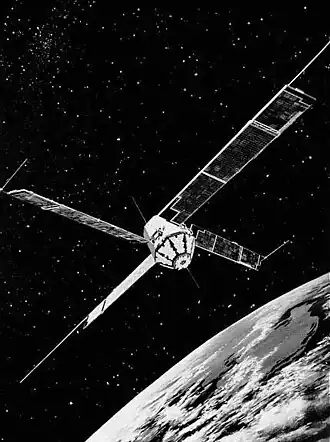Explorer S-66
 Explorer S-66 satellite | |
| Names | BE-A Beacon Explorer-A NASA S-66 |
|---|---|
| Mission type | Ionospheric research |
| Operator | NASA |
| COSPAR ID | EXS-66A |
| Mission duration | Failed to orbit |
| Spacecraft properties | |
| Spacecraft | Explorer S-66 |
| Spacecraft type | Beacon Explorer |
| Bus | Transit-Bus |
| Manufacturer | Johns Hopkins University Applied Physics Laboratory |
| Launch mass | 120 kg (260 lb) |
| Dimensions | 24.5 × 45.7 cm (9.6 × 18.0 in) |
| Power | 4 deployable solar arrays and batteries |
| Start of mission | |
| Launch date | 19 March 1964, 11:13:41 GMT |
| Rocket | Thor-Delta B (Thor 391 / Delta 024) |
| Launch site | Cape Canaveral, LC-17A |
| Contractor | Douglas Aircraft Company |
| End of mission | |
| Destroyed | Failed to orbit |
| Orbital parameters | |
| Reference system | Geocentric orbit (planned) |
| Regime | Low Earth orbit |
| Instruments | |
| Langmuir Probe Laser Tracking Radio Frequency Beacon | |
Explorer program | |
Explorer S-66 (also called BE-A, acronym of Beacon Explorer-A), was a NASA satellite launched on 19 March 1964 by means of a Thor-Delta B launch vehicle, but it could not reach orbit due to a vehicle launcher failure.[1]
Spacecraft
Beacon Explorer-A was a small ionospheric research satellite instrumented with an electrostatic probe, a 20-, 40-, and 41-Hz ionospheric radio beacon, a passive laser tracking reflector, and a navigation experiment. Its primary objective was to obtain worldwide observations of total electron content between the spacecraft and the Earth. The spacecraft was an octagonal right prism 24.5 × 45.7 cm (9.6 × 18.0 in)-diameter terminated on top with a truncated octagonal pyramid on which the laser reflectors were mounted. Appended were four hinged paddles carrying solar cells. Each paddle was 167.6 × 25.4 cm (66.0 × 10.0 in).[1]
Launch
During the third stage operation, a malfunction of unidentified origin prevented successful orbit. Satellite and third stage descent were in the south Atlantic Ocean with no useful scientific data obtained.[1]
See also
References
- ^ a b c "Display: Beacon Explorer-A EXS-66A". NASA. 28 October 2021. Retrieved 7 November 2021.
 This article incorporates text from this source, which is in the public domain.
This article incorporates text from this source, which is in the public domain.
.png)